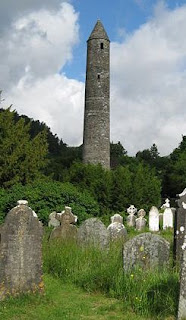Today I was on a particularly dangerous mission for the University of Dublin. Well, dangerous for me, anyway. The University was very keen on me getting inside the infamous Kilmainham Gaol (“jail” to you Yanks.) They wanted me to record what the palce was like while it was in operation.
 |
| Kilmainham Gaol as it looks now in 1900 |
When I quoted Matthew 25:36 which says Christians should minister to prisoners, the guard looked bored. Apparently I was not the first. Indeed I was not the only person there wanted to preach to inmates. We were told to stay in the main hall and speak through the bars. They also frisked us for weapons to make sure none of us was there to aid in an escape. I think we were only tolerated because they hoped we might reform an inmate or two.
As I came into the huge oppressive-looking atrium of the East Wing lined with three stories of cells, it made me feel very small. The depression was palatable. I looked at the other ministers who had been here before, admiring their courage, for even though I knew I was going to get out today, I knew I would have nightmares about this place.
 |
| East Wing of Kilmainham Gaol |
I might as well have said, would anyone like to cuss out the Englishman. The prison is run by the government which is based in London. So I silently let the half dozen who heard me vent.
When they settled down I said, “If you must know, I am in favor of Home Rule. Ireland is your country, you should be allowed to run it.”
Then I heard a voice. “Vicar! Over here!”
 I stepped over, keeping the foot distance we were instructed by the guards to keep, least we be grabbed and injured. I knelt down to peer through the little door just large enough to pass a bowl of food. I expected to see looking back the face of a brute who had murdered his family, but instead found a pair of soulful blue eyes on a young face.
I stepped over, keeping the foot distance we were instructed by the guards to keep, least we be grabbed and injured. I knelt down to peer through the little door just large enough to pass a bowl of food. I expected to see looking back the face of a brute who had murdered his family, but instead found a pair of soulful blue eyes on a young face.“Yes, my son?” I tried to sound priestly. “What may I do for you?”
“Can you get a message to my mother and sister? Let them know I’m okay?”
“They don’t let you write?”
“Yes, but an eyewitness might put them more at ease. They know I would say I was fine whether I was or not.”
“All right.” I pulled out a pad and paper. “Let me get the address.”
“I’m sorry about all those names I called you, Vicar. It’s just--well--it’s just that Home Rule is why I’m here.”
The young man told me his name was Sean Kane and proceeded to tell me how on the night Queen Victoria arrived in Dublin, Maude Gonne had organized a torchlight parade to protest British rule. It was meant to be a peaceful demonstration, but Dublin officials had no tolerance for anything but niceties toward Her Majesty. The police stormed the protestors beating them with batons to chase them off.
The Sean’s voice tightened. “One of those blighters took a swing at my sister. I stopped him by hitting him in the eye. I got six months for assaulting an officer. I was told I got off easy.”
Yes, as I said Kilmainham is a maximum security prison full of thieves and murderers. It is also where all political prisoners have been brought since it first opened in 1796. Indeed just about every Nationalist leader, both violent and peaceful, has been a “guest” in this prison. I hadn’t expected to find any political prisoners here in 1900. Apparently just no famous patriots are here right now.
Many political prisoners were released after they had been taught a lesson. Some were hanged. This is the prison all the rebels in the Easter Rising of 1916 were brought. Out in the courtyard is where the fifteen leaders will be executed by firing squad without a proper trial. (I mention this in my blog on the Easter Rising.)
In 1924 the Irish Free State will close down Kilmainham Gaol. Torn between tearing down this symbol of foreign oppression or preserving it as the site of so many martyrdoms, Ireland will let Kilmainham sit and rot for decades. Finally in 1971, after years of restoration, the former prison will be opened as a museum to the fight for freedom.
The Sean said he wasn’t sorry for protecting his sister. He also wasn’t sorry he protested. From the sound of his voice I had a feeling he would return to Kilmainham Gaol after the Easter Rising. I’m happy to say Sean’s name is not on the list of those that will be executed.
After talking an hour with Sean I left that dreadful place. I did visit his mother as I had promised. I noticed his sister looked in good health. She told me tearfully she had only been able to escape because of her brother’s sacrifice. I told her Sean Kane would be remembered. Indeed he will when I return to the 27th century with our interview. I wondered how many other forgotten heroes have stayed in Kilmainham Gaol?
























